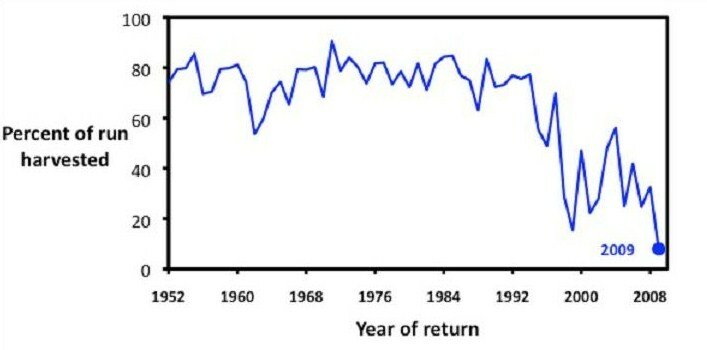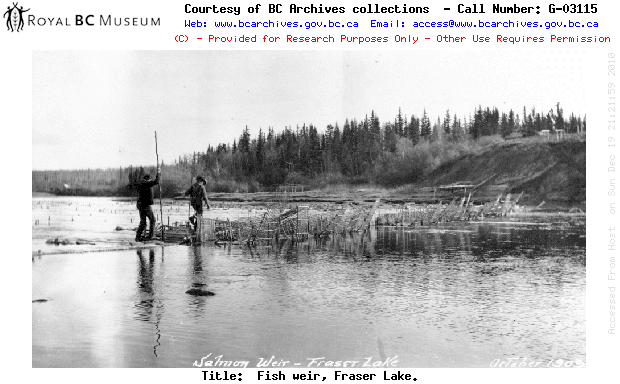
one might wrongly assume that "deterrence" is the reason...
.
It has been a little while since I’ve had to do two posts in one day… however the news on the wire today regarding the Harper Government assault on fish, fisheries, coastal communities and so on — is impressive.
The graph above comes from information presented at the Cohen Commission into Declines of Fraser River sockeye.
It also comes from a press release put out today by Otto Langer an over 30-year DFO staffer, and even longer-time award-winning, fish biologist.
The full press release can be downloaded here:
Here are some lowlights of the apparent Harper Conservative plan to sneak a gutting of the Fisheries Act on to the back of the upcoming Budget Ombnibus Bill.
_ _ _ _ _ _ _ _

Langer's Fisheries Act historical summary
.
Here’s the current reading of Section 35 of the Fisheries Act — pretty clear and to the point, yet still challenging to prove in court…:

current Section 35 of Canada's Fisheries Act.
.
Here’s the new weasel-word, bumpf-filled, ambiguity-laced — giving Ministerial fettering to everything — language that is trying to be sneaked in without consultation with anyone:

New Reform... ahhh... i mean Conservative government weasel words proposed for Fisheries Act.
.
As Langer points out in his press release:
The newly drafted provision [35(1) above that takes out ‘habitat’ and adds ‘fish’] legislation is not intended to protect fish habitat in any matter whatsoever.
Langer’s anecdote to this is great… he remembers a time when DFO used to hand out pens at conferences and such that said:
NO HABITAT, NO FISH!
Fitting close to the press release:

nothing like a 'neutering' to ruin your day...
.
_ _ _ _ _ _ _ _
In closing this pathetic state of affairs and ongoing shitshow at DFO… (and other areas of Canada)…
One could look at the graph above and suggest to Mr. “tough-on-crime” Harper that it seems crimes are going down everywhere… even in the destruction of fisheries habitat.
Look at this wonderful graph proving the ever effective crime-fighting tactic of: DETERRENCE.
Must be that Fisheries Act violations have just got so nasty and onerous for polluters that the need for investigations is dwindling, and deterrence is working….
…hmmmm….
Somehow I doubt it.
48 convictions in 1998 down to 1 conviction in 2008.
This is called a gutting of staff, balls, and teeth — and most sadly, destruction of fish habitat, especially wild salmon’s, at an alarming rate.
This also means an enforcement and compliance division within DFO that probably feels about as proud of their job as a child labourer putting together those blue jeans you’re wearing…
Nothing like job security, meaningfulness, and pride to really make a Ministry sing with glee…
_ _ _ _ _ _ _ _
Goal for Harper and his Reform buddies… 0 [zero] convictions, under the Fisheries Act.
Let’s get tough on crime, everybody…
(or fish, i suppose, depending on which way you look at it).
Plus, I was just wondering (in reference to the ‘proposed’ amendments) … ummm…
…which “fish” does not have an “ecological value“?
And could somebody please show me the legal definition of “ecological value” or even ‘economic’ or ‘cultural value’ for that reason.
That’s the point.
This is about as gray, fuzzy, and blurry as that Hawiian highway was for Gordon Campbell back in the early 2000s. [oh right, it was his personal holiday… not government business]
Translation…. 0 convictions.
(and tarsands expansion, and pipelines rammed down BC’ers throats, and more fracking, and so on and so on.)
Hold on to your hats, here comes George W. Bush Canadian-style. (sans the required apology… “oh sorry, excuse me new NDP leader” says PM-bully Harper…)
(NOT).
Think the Fisheries Act is going to get neutered… well… this ain’t nothing yet (under this ‘majority)… going to be a whole lot of current legislation losing their balls… going to be an all out choir fest.
_ _ _ _ _ _ _
And just to really ruin your fishy day… take a look at most recent post at Alex Morton’s website:
She had Atlantic salmon tested that she bought at 3 B.C. supermarkets (most likely Vancouver Is.)
Five of them tested positive for ISA [infectious salmon anemia].
Yet, the Feds, DFO, the Province and the Canadian Food Inspection Agency continue to deny that ISA exists on the BC coast.
_ _ _ _ _ _
Oh wait… I can hear the response from Harpers PMO office…
“ohhhh…. you mean thatISA… we thought you were talking about a different ISA…(like the cartoon character from Dora the Explorer… or something..)”

ISA from Dora the Explorer
…oh yeah, we’ve actually known that that ISA… that nasty salmon thingy…has actually been here for decades… probably since the last Conservative majority (the real Conservatives… think Mulroney, and Clarke and stuff…) …sorry for the confusion, everyone…”
[Harper (whispering): “hey Ashfield, somebody go muzzle a scientist or audit an enviro-terrorist organization or something…”]















